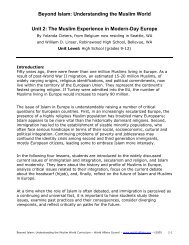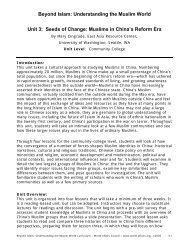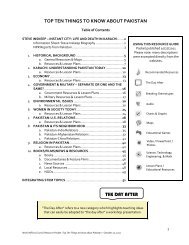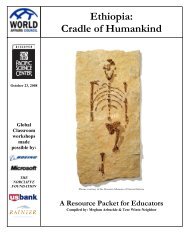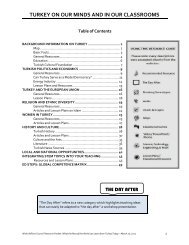The Japanese Approach to Environmental Issues - World Affairs ...
The Japanese Approach to Environmental Issues - World Affairs ...
The Japanese Approach to Environmental Issues - World Affairs ...
You also want an ePaper? Increase the reach of your titles
YUMPU automatically turns print PDFs into web optimized ePapers that Google loves.
Energy imports, net (% of energy use) 81.2 30.3Electric power consumption (kWh per capita) 8233 13648Electricity production from coal sources (% of <strong>to</strong>tal) 28.3 50.5CO2 emissions (kg per 2005 PPP $ of GDP) 4 0.3 0.5CO2 emissions (metric <strong>to</strong>ns per capita) 9.8 20.6PM10, country level (micrograms per cubic meter) 5 31 22Passenger cars (per 1,000 people) 441 461Renewable internal freshwater resources per capita3365 9443(cubic meters)Annual freshwater withdrawals, <strong>to</strong>tal (% of internal21 17resources)Annual freshwater withdrawals, agriculture (% of62 41<strong>to</strong>tal freshwater withdrawal)Improved water source (% of population with access) 100 100Improved water source, rural (% of rural population100 100with access)Improved water source, urban (% of urban100 100population with access)Improved sanitation facilities (% of population with100 100access)Improved sanitation facilities, rural (% of rural100 100population with access)Improved sanitation facilities, urban (% of urban100 100population with access)Mortality rate, under-5 (per 1,000) 4 8Adjusted savings: gross savings (% of GNI) 6 26.4 12.6Adjusted savings: consumption of fixed capital (% of14.0 12.3GNI) 7Adjusted savings: net national savings (% of GNI) 8 12.4 0.3Adjusted savings: education expenditure (% of GNI) 9 3.1 4.8Adjusted savings: energy depletion (% of GNI) 10 0.0 1.4Adjusted savings: mineral depletion (% of GNI) 11 0.0 0.1Adjusted savings: carbon dioxide damage (% of0.2 0.3GNI) 12Adjusted savings: particulate emission damage (% of0.5 0.3GNI) 13Adjusted net savings, including particulate emission14.9 2.9damage (% of GNI) 14 Source: <strong>The</strong> <strong>World</strong> Bank http://www.worldbank.org/*Notes1. Arable land includes land defined by the FAO as land under temporary crops (double-cropped areas are counted once), temporary meadows formowing or for pasture, land under market or kitchen gardens, and land temporarily fallow. Land abandoned as a result of shifting cultivation isexcluded.2. GEF benefits index for biodiversity is a composite index of relative biodiversity potential for each country based on the species represented in eachcountry, their threat status, and the diversity of habitat types in each country. <strong>The</strong> index has been normalized so that values run from 0 (no biodiversitypotential) <strong>to</strong> 100 (maximum biodiversity potential).3. GDP per unit of energy use is the PPP GDP per kilogram of oil equivalent of energy use. PPP GDP is gross domestic product converted <strong>to</strong> 2000constant international dollars using purchasing power parity rates. An international dollar has the same purchasing power over GDP as a U.S. dollarhas in the United States.4. Carbon dioxide emissions are those stemming from the burning of fossil fuels and the manufacture of cement. <strong>The</strong>y include carbon dioxideproduced during consumption of solid, liquid, and gas fuels and gas flaring.5. Particulate matter concentrations refer <strong>to</strong> fine suspended particulates less than 10 microns in diameter (PM10) that are capable of penetrating deepin<strong>to</strong> the respira<strong>to</strong>ry tract and causing significant health damage. Data for countries and aggregates for regions and income groups are urban-populationweighted PM10 levels in residential areas of cities with more than 100,000 residents. <strong>The</strong> estimates represent the average annual exposure level of theaverage urban resident <strong>to</strong> outdoor particulate matter. <strong>The</strong> state of a country’s technology and pollution controls is an important determinant ofparticulate matter concentrations.6. Gross savings are the difference between gross national income and public and private consumption, plus net current transfers. <strong>World</strong> Bank nationalaccounts data files.7. Consumption of fixed capital represents the replacement value of capital used up in the process of production.8. Net national savings are equal <strong>to</strong> gross national savings less the value of consumption of fixed capital.9. Education expenditure refers <strong>to</strong> the current operating expenditures in education, including wages and salaries and excluding capital investments inbuildings and equipment.10. Energy depletion is equal <strong>to</strong> the product of unit resource rents and the physical quantities of energy extracted. It covers crude oil, natural gas, andcoal.11. Mineral depletion is equal <strong>to</strong> the product of unit resource rents and the physical quantities of minerals extracted.12. Carbon dioxide damage is estimated <strong>to</strong> be $20 per <strong>to</strong>n of carbon (the unit damage in 1995 U.S. dollars) times the number of <strong>to</strong>ns of carbonemitted.13. Particulate emissions damage is calculated as the willingness <strong>to</strong> pay <strong>to</strong> avoid mortality attributable <strong>to</strong> particulate emissions.14. Adjusted net savings are equal <strong>to</strong> net national savings plus education expenditure and minus energy depletion, mineral depletion, net forestdepletion, and carbon dioxide and particulate emissions damage.4




